Measure the brake lining thickness (C).
Measurement does not include brake shoe thickness.
Brake lining thickness
Standard : 4.5 mm (0.177 in.)
Service limit : 1.0 mm (0.039 in.)
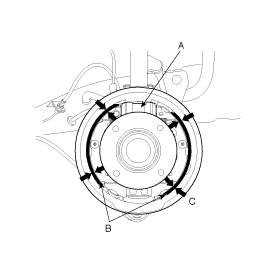
Frequent inhalation of brake pad dust, regardless of material composition, could be hazardous to your health.
Avoid breathing dust particles.
Never use an air hose or brush to clean brake assemblies.
Contaminated brake linings or drums reduce stopping ability.
Block the front wheels before jacking up the rear of the vehicle.
Raise the rear of the vehicle, and make sure it is securely supported.
Release the parking brake, and remove the rear brake drum.
Check the wheel cylinder (A) for leakage.
Check the brake linings (B) for cracking, glazing, wear, and contamination.
Measure the brake lining thickness (C).
Measurement does not include brake shoe thickness.
Brake lining thickness
Standard : 4.5 mm (0.177 in.)
Service limit : 1.0 mm (0.039 in.)

If the brake lining thickness is less than the service limit, replace the brake shoes as a set.
Check the bearings in the hub unit for smooth operation. If it requires servicing, replace it.
Measure the inside diameter of the brake drum with inside vernier calipers.
Drum inside diameter:
Standard : 228.6 mm (9 in.)
Service limit : 230.6 mm (9.079in.)
Drum roundness
Service limit : 230.6mm (0.0024in.)
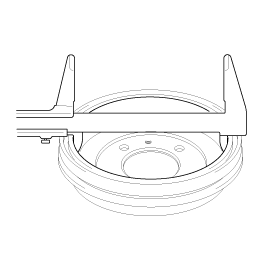
If the inside diameter of the brake drum is more than the service limit, replace the brake drum.
Check the brake drum for scoring, grooves, and cracks.
Frequent inhalation of brake pad dust, regardless of material composition, could be hazardous to your health.
Avoid breathing dust particles.
Never use an air hose or brush to clean brake assemblies.
Remove the shoe hold down pins (B) by pushing the shoe hold cup washer (C) and turning them.
Disengage the upper return spring (A).
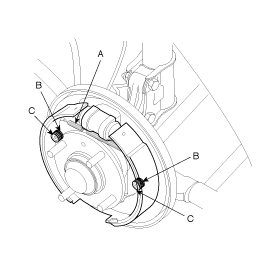
Remove the lower shoe return spring (B) as removing the brake shoe assembly(A). Make sure not to damage the dust cover on the wheel cylinder.
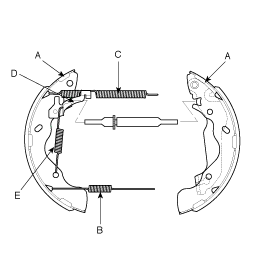
Disconnect the parking brake cable from the parking brake lever.
Remove the brake shoe assembly.
Remove the upper return spring (C), shoe adjuster lever (D), and separate the brake shoes.
Disconnect the brake line (A) from the wheel cylinder (B).
Remove the bolt (C) and the wheel cylinder from the backing plate(D).
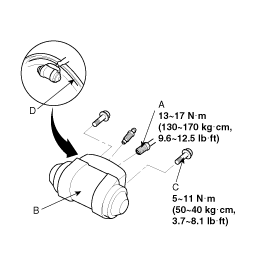
Do not spill brake fluid on the vehicle: it may damage the paint; if brake fluid does contact the paint. Wash it off immediately with water.
To prevent spills, cover the hose joints with rags or shop towels.
Use only a genuine wheel cylinder special bolt.
Apply sealant (C) between the wheel cylinder (A) and backing plate (B), and install the wheel cylinder.

Connect the brake tubes (D) to the wheel cylinder.
Connect the parking brake cable to the parking brake lever.
Clean the threaded portions of adjuster sleeve (A) and push rod female (B). Grease the threads of the adjuster assembly, turn the adjuster bolt (C), adjusting the length of the shoe ajuster assembly.

Hook the shoe adjuster spring (D) to the adjuster lever first, then to the brake shoe.
Install the shoe adjuster assembly and upper return spring (E), noting the installation direction. Be careful not to damage the wheel cylinder dust covers.
Install the lower return spring (F).
Grease brake cylinder to the sliding surfaces as shown below. Wipe off any excess. Don't get grease on the brake linings.
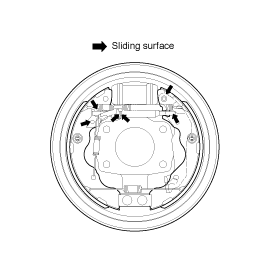
Grease brake cylinder to the brake shoe ends and opposite edges of the as shoes as shown below.
Wipe off any excess. Don't get grease on the brake linings.
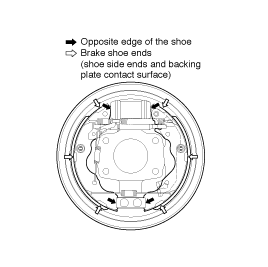
Grease brake shoes (A) onto the backing plate. Be careful not to damage the wheel cylinder dust covers.
Install the shoe hold down pins (B) and the shoe hold down washers (C).

Install the upper return spring (D).
Install the brake drum.
Bleed the brake system,after refilling the brake fluid.
Depress the brake pedal several times to set the self-adjusting brake.
Adjust the parking brake.